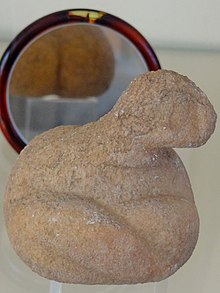Fat woman from Saliagos
The Fat Lady of Saliagos is a sitting, naked female figure with excessively large buttocks. The marble figure from the Neolithic period is dated between 5300 and 4500 BC. Dated. It was found in 1964 during excavations by the British School at Athens under John D. Evans and Colin Renfrew on the uninhabited Cycladic island of Saliagos . It is exhibited with other finds from Saliagos in a showcase in the Paros Archaeological Museum under inventory number 887.
description
The figure is not completely preserved; the head and the right shoulder are missing. The height obtained is 5.8 cm. In addition, the upper area is damaged by corrosion. The formerly white, medium-grain marble with a grain size of up to about 1 mm has a rather rough surface with a reddish discoloration due to weathering. Despite the missing parts, a reconstruction of the idol is possible, as there are similarities in posture and other details with the late Neolithic figurine from Sangri on Naxos (NM 210). Both are counted among a type of fertility idols widespread in the Neolithic agricultural society of Southeast Europe and Asia Minor.
With the elbows on the sides and the forearms above the waist, the fingertips could meet in the middle of the body. However, only the left arm is partially preserved and clearly modeled on the front of the body. A thick roll of bacon can be seen underneath. It is separated from the shoulder with a cut on the back of the body. Two more incised lines show fat pads on the lower back. The preserved upper part of the figure looks almost slim compared to the huge buttocks that protrude far on the back. The buttocks are divided by a deep incision. At right angles to this, two incised lines mark the transition from thigh to buttocks on the underside. The clumsy legs are crossed on the front. The right leg is worked more clearly with a slight narrowing, presumably to indicate the foot. The left leg is not separated in detail.
For the excavators, the discovery of a Neolithic figurine was less surprising than the discovery of a violin idol with a typical early Bronze Age shape. Such schematic idols are an important feature of the Grotta Pelos culture and significant evidence that opposing idol types coexisted in the Cyclades even earlier. Later examples can be found in a grave find from the Grotta Pelos phase and in a grave in Akrotiri on Naxos.
literature
- John D. Evans , Colin Renfrew : Excavations at Saliagos: near Antiparos . In: The British School at Athens (Ed.): The Annual of the British School at Athens , Supplementary Volume 5) . Thames and Hudson, London 1968, pp. 62 f . (Figs. 75-8, Plates XLII-XLV)
- Werner Ekschmitt : The Cyclades. Bronze Age, Geometric and Archaic Age . Philipp von Zabern, Mainz 1993, ISBN 3-8053-1533-3 , p. 15-17 .
- Colin Renfrew: The Sculptures of Neolithic Saliagos. In: Marisa Marthari, Colin Renfrew, Michael Boyd (Eds.): Early Cycladic Sculpture in Context. Oxbow, Oxford & Philadelphia 2017, ISBN 978-1-78570-195-5 , pp. 27 f.
Individual evidence
- ↑ Evans & Renfrew 1968, p. 63
- ^ Konstantinos Zachos: The Neolithic Period in Naxos . In: Lila Marangou (ed.): Cycladic Culture-Naxos in the 3rd Millenium BC . Nicholas P. Goulandris Foundation-Museum of Cycladic Art, Athens 1990, ISBN 960-7064-02-X , p. 31 . ; Ekschmitt 1993, p. 16


